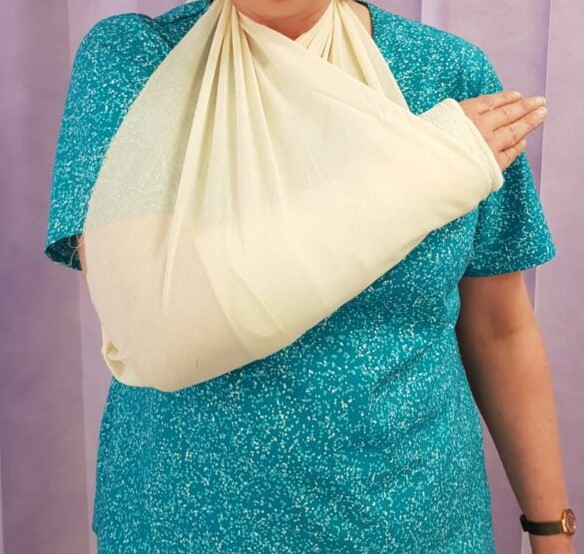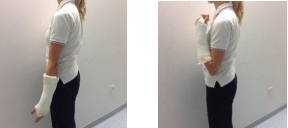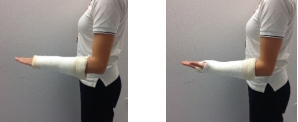Download and print as a PDF (408kB pdf)
On this page
- What is this information about?
- Why Have I been given this information?
- What is a distal radius fracture?
- How long might it take for my distal radius fracture to heal?
- Will my arm be in a plaster cast or a splint while my fracture is healing?
- What can I do to reduce the pain or swelling I may have after my injury?
- What other advice should I follow in the first few days after I have broken my distal radius?
- I am over 50 years old. Could my fracture be a sign that I might have fragile or brittle bones?
- How soon after my injury can I return to work?
- How soon after my injury can I start driving again?
- What symptoms might I get that mean I should return to A&E straight away?
- What must I do if my plaster cast cracks, becomes loose or is rubbing my skin?
- What will happen further on into my recovery?
- Where can I find further information or advice if I need it after I have read this information?
What is this information about?
This information is about how you can help your distal radius fracture (broken distal radius bone) to heal. It tells you what you should and should not do if you have a broken distal radius. It includes advice on:
- how you can reduce pain and swelling caused by your broken radius
- how to use your sling
- what exercises you can do to help your fracture to heal
- how long it might take for your fracture to heal
- symptoms that mean you should return to the Emergency Department (A&E)
- how soon after your injury you can return to work, driving and other activities
Why Have I been given this information?
You have been given this information because you have been diagnosed in A&E as having a broken distal radius bone. Following the advice in this information will:
- help your fracture to heal
- avoid further damage
- keep you as comfortable as possible while your fracture is healing
What is a distal radius fracture?

The radius is one of the two bones in the forearm. The other is the ulna. The distal part of the radius is the end nearest your wrist – see X-ray image.
How long might it take for my distal radius fracture to heal?
It usually takes about six weeks for this type of fracture to heal.
Will my arm be in a plaster cast or a splint while my fracture is healing?
We will put your arm in a plaster cast or a splint to start with. These keep your fracture in a position that will help it to heal and allow room for any swelling. You may not need to wear your plaster cast or splints for all the period when your fracture is healing. The Virtual Fracture Clinic (VFC) will advise you when you no longer need it.
Do look after this plaster cast or splint by keeping it dry.
What can I do to reduce the pain or swelling I may have after my injury?
- if you are in pain, take your usual pain killers. Follow the dose instructions on the packet. If you are struggling with pain do speak to your GP or pharmacist.
- use the sling that we will give you for the first few days after your injury to reduce swelling.
- you should not need it after this, but you may keep wearing it if it is more comfortable for you.
- use the sling to keep your hand held high up just below your shoulder as in the picture below:

What other advice should I follow in the first few days after I have broken my distal radius?
Do
- raise your wrist if it is throbbing.
- avoid sitting or standing with your arm down by your side. You can use your sling or put your hand on top of some pillow. This helps reduce swelling and prevents the plaster from becoming too tight.
- rest your arm at first. This will help your broken radius to start to heal.
- move the joints in your arm and fingers apart from your broken wrist. This includes your fingers, thumbs, elbow, and shoulders. You should be able to move your fingers around as much as usual when you are wearing your cast.
- Keep doing this throughout the time when your fracture is healing. It should help to stop your arm from getting stiff.
- use your hand for light activities such as using cutlery or preparing food
- stop smoking. Smoking slows bone healing. If you would like help with stopping smoking talk to your GP or visit www.smokefree.nhs.uk for further information.
Do not
- rest with your weight on your plaster (for example lie down with your plaster underneath your body) for the first 48 hours (two days).
- put anything heavy on your plaster.
- adjust your plaster. If the edges of your plaster are rubbing, come back to the Plaster Technicians in the Plaster Room. They will trim your plaster so that it fits more comfortably.
I am over 50 years old. Could my fracture be a sign that I might have fragile or brittle bones?
Do these exercises to help prevent stiffness.
Do each exercise up to 10 times, two to three times a day. Do not force any movement.
Finger exercises:

Elbow exercises:

Bend and straighten.

Turn palm up and palm down.
These exercises may be uncomfortable but should not make your pain worse after you have completed them. If your pain gets much worse stop doing the exercises and speak with your GP or physiotherapist before you start them again.
How soon after my injury can I return to work?
You can return to work as soon as you are comfortable to do so but do not use your injured arm at work until the VFC have advised you that you that you can.
How soon after my injury can I start driving again?
You should not drive while you are still wearing your cast. After your cast is removed you may drive again once you feel you can safely deal with all emergency situations without hesitation. For example, you must be able to stop the car quickly and in full control and safely avoid obstacles.
What symptoms might I get that mean I should return to A&E straight away?
Do go to A&E straight away if you get any of these symptoms:
- you are in more pain
- your swelling gets worse
- you feel numb or have pins and needles (a pricking, burning, tingling or numbing feeling) in your arm that has been broken
- you cannot move your fingers
- your fingers turn a blue colour. This may be difficult to see in black or brown skin and may look grey.
What must I do if my plaster cast cracks, becomes loose or is rubbing my skin?
Do return to the plaster room. Contact the plaster room before you come in.
- Plaster Room Worthing Hospital phone: 01903 205 111 ext.85445
- Plaster Room St. Richard’s Hospital phone: 01243 788 122 ext. 33393
What will happen further on into my recovery?
Your fracture should be healed after six weeks.
The VFC will send you an appointment to have your cast removed. After your cast is removed you should be able to return to doing the things that you used to. Be guided by your pain. If you are still in pain, you may have to wait a little longer before you can do some activities.
Where can I find further information or advice if I need it after I have read this information?
Please use the NHS Website www.nhs.uk for general medical information. You can contact the NHS 111 online (111.nhs.uk) or phone (phone: 111) service for information and advice on how to get treatment if you think you may need it.
You can also contact your GP surgery.
There is a walk-in Minor Injuries Unit at Bognor War Memorial Hospital which can help with minor to moderate illnesses and injuries. If you are not sure whether your condition can be treated at the Minor Injuries Unit, please phone 01243 623 563 first to check.
This information is intended for patients receiving care in Worthing and St.Richard’s Hospital Chichester.
The information here is for guidance purposes only and is in no way intended to replace professional clinical advice by a qualified practitioner.